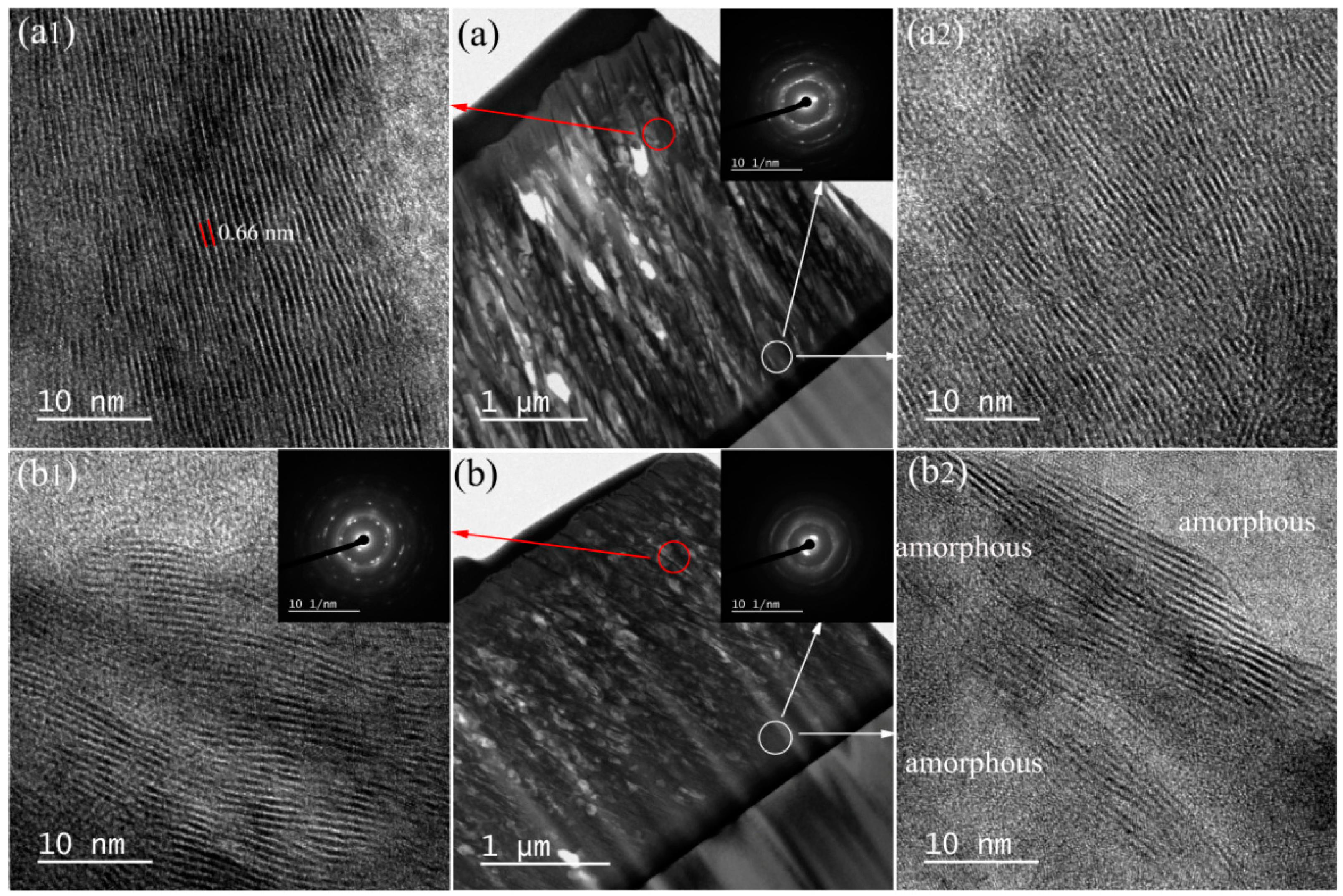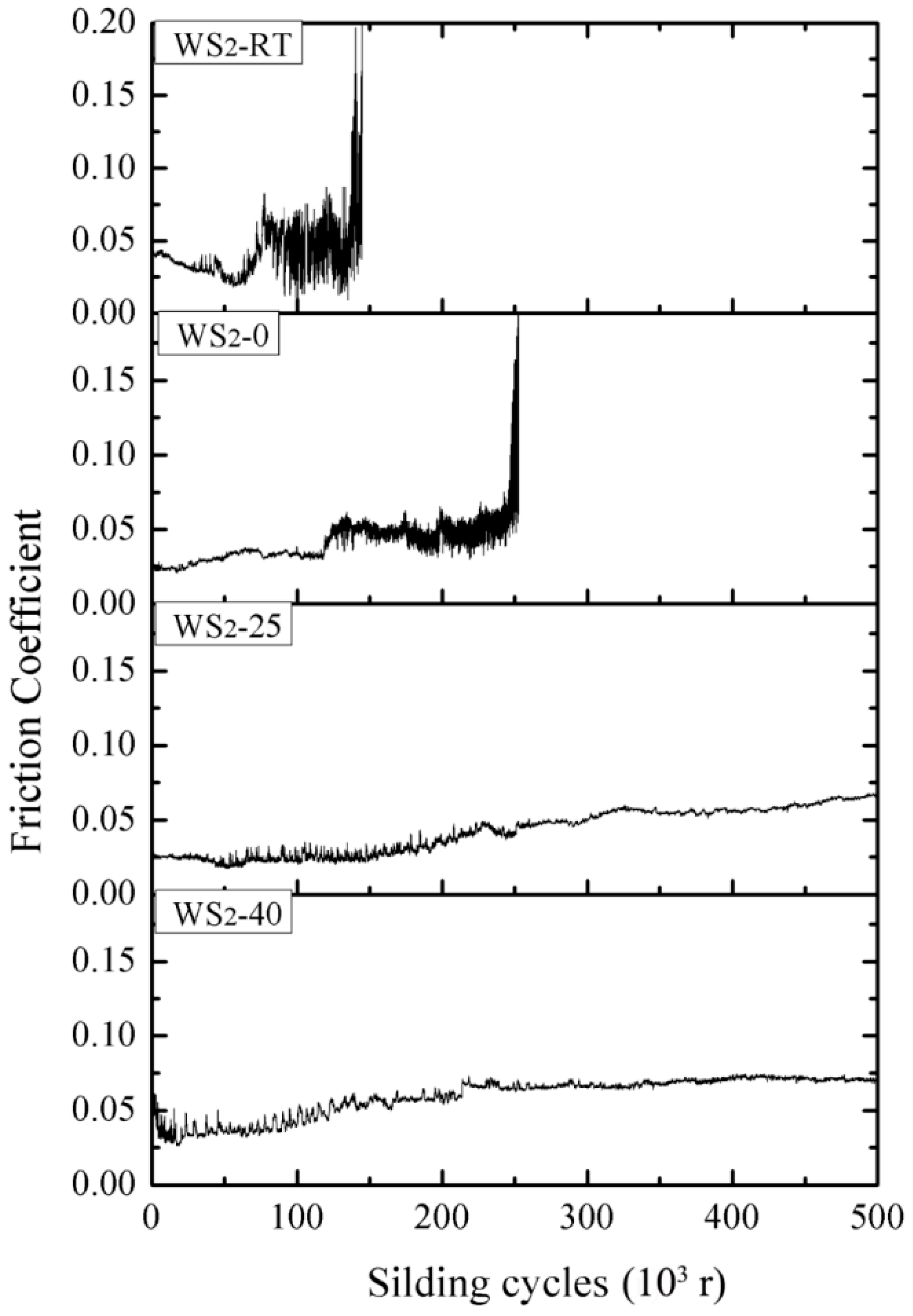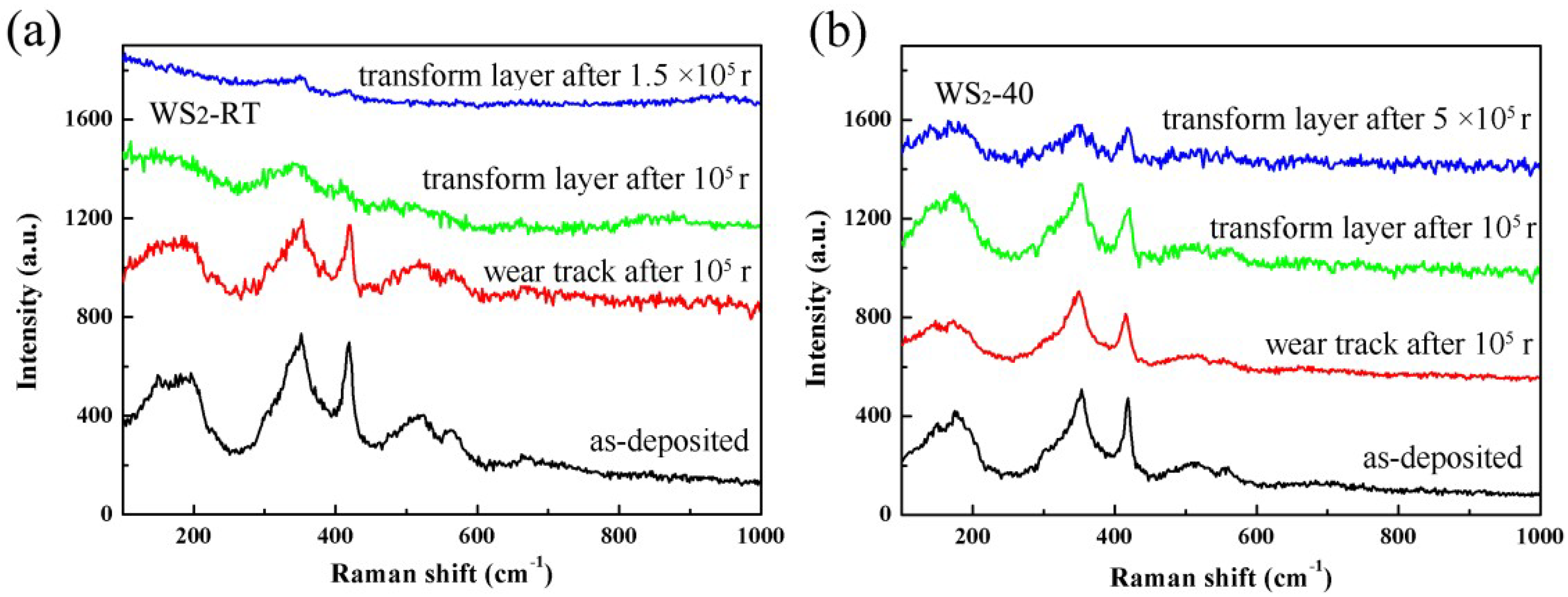Low Deposition Temperature-Induced Changes of the Microstructure and Tribological Property of WS2 Film
Abstract
:1. Introduction
2. Experiment
2.1. Sample Preparation
2.2. Film Characterization and Tribological Measurements
3. Results and Discussion
4. Conclusions
Author Contributions
Funding
Conflicts of Interest
References
- Banerjee, T.; Chattopadhyay, A. Influence of substrate bias on structural and tribo-mechanical properties of pulsed magnetron sputtered TiN–WSx hard-lubricious coating. Tribol. Int. 2018, 123, 81–91. [Google Scholar] [CrossRef]
- Luo, T.; Wang, P.; Qiu, Z.; Yang, S.; Zeng, H.; Cao, B. Smooth and solid WS2 submicrospheres grown by a new laser fragmentation and reshaping process with enhanced tribological properties. Chem. Commun. 2016, 52, 10147–10150. [Google Scholar] [CrossRef] [PubMed]
- Scharf, T.; Prasad, S.; Dugger, M.; Kotula, P.; Goeke, R.; Grubbs, R. Growth, structure, and tribological behavior of atomic layer-deposited tungsten disulphide solid lubricant coatings with applications to MEMS. Acta Mater. 2006, 54, 4731–4743. [Google Scholar] [CrossRef]
- Zeng, Y.; He, F.; Wang, Q.; Yan, X.; Xie, G. Friction and wear behaviors of molybdenum disulfide nanosheets under normal electric field. Appl. Surf. Sci. 2018, 455, 527–532. [Google Scholar] [CrossRef]
- Scharf, T.W.; Prasad, S.V. Solid lubricants: A review. J. Mater. Sci. 2013, 48, 511–531. [Google Scholar] [CrossRef]
- Bulbul, F.; Efeoğlu, I.; Arslan, E.; Efeoglu, I. The effect of bias voltage and working pressure on S/Mo ratio at MoS2–Ti composite films. Appl. Surf. Sci. 2007, 253, 4415–4419. [Google Scholar] [CrossRef]
- Shi, J.P.; Tong, R.; Zhou, X.B.; Gong, Y.; Zhang, Z.P.; Ji, Q.Q.; Zhang, Y.; Fang, Q.Y.; Gu, L.; Wang, X.N.; et al. Temperature-mediated selective growth of MoS2/WS2 and WS2/MoS2 vertical stacks on Au foils for direct photocatalytic applications. Adv. Mater. 2016, 28, 10664. [Google Scholar] [CrossRef]
- Arslan, E.; Totik, Y.; Efeoglu, I. Comparison of structure and tribological properties of MoS2–Ti films deposited by biased-dc and pulsed-dc. Prog. Org. Coat. 2012, 74, 772–776. [Google Scholar] [CrossRef]
- Gustavsson, F.; Jacobson, S.; Cavaleiro, A.; Polcar, T. Ultra-low friction W–S–N solid lubricant coating. Surf. Coat. Technol. 2013, 232, 541–548. [Google Scholar] [CrossRef] [Green Version]
- Polcar, T.; Gustavsson, F.; Thersleff, T.; Jacobson, S.; Cavaleiro, A. Complex frictional analysis of self-lubricant W–S–C/Cr coating. Faraday Discuss. 2012, 156, 383–401. [Google Scholar] [CrossRef] [PubMed]
- Xu, S.; Sun, J.; Weng, L.; Hua, Y.; Liu, W.; Neville, A.; Hu, M.; Gao, X. In-situ friction and wear responses of WS2 films to space environment: Vacuum and atomic oxygen. Appl. Surf. Sci. 2018, 447, 368–373. [Google Scholar] [CrossRef]
- Singh, H.; Mutyala, K.C.; Mohseni, H.; Scharf, T.W.; Evans, R.D.; Doll, G.L. Tribological performance and coating characteristics of sputter deposited Ti doped MoS2 in rolling and sliding contact. Tribol. Trans. 2015, 58, 767–777. [Google Scholar] [CrossRef]
- Hsu, K.W.; Zhu, Y.; Yao, N.; Firth, S.; Clark, R.; Kroto, H.W.; Walton, D. Titanium-doped molybdenum disulfide nanostructures. Adv. Funct. Mater. 2001, 11, 69–74. [Google Scholar] [CrossRef]
- Strapasson, G.; Badin, P.C.; Soares, G.V.; Machado, G.; Figueroa, C.A.; Hubler, R.; Gasparin, A.L.; Baumvol, I.J.R.; Aguzzoli, C.; Tentardini, E.K. Structure, composition, and mechanical characterization of dc sputtered TiN–MoS2 nanocomposite thin films. Surf. Coat. Technol. 2011, 205, 3810–3815. [Google Scholar] [CrossRef]
- Scharf, T.; Kotula, P.; Prasad, S.; Kotula, P. Friction and wear mechanisms in MoS2/Sb2O3/Au nanocomposite coatings. Acta Mater. 2010, 58, 4100–4109. [Google Scholar] [CrossRef]
- Stoyanov, P.; Chromik, R.R.; Goldbaum, D.; Lince, J.R.; Zhang, X. Microtribological performance of Au–MoS2 and Ti–MoS2 coatings with varying contact pressure. Tribol. Lett. 2010, 40, 199–211. [Google Scholar] [CrossRef]
- Arslan, E.; Bulbul, F.; Alsaran, A.; Çelik, A.; Efeoglu, I. The effect of deposition parameters and Ti content on structural and wear properties of MoS2Ti coatings. Wear 2005, 259, 814–819. [Google Scholar] [CrossRef]
- Lince, J.R. Tribology of Co-sputtered Nanocomposite Au/MoS2 solid lubricant films over a wide contact stress range. Tribol. Lett. 2004, 17, 419–428. [Google Scholar] [CrossRef]
- Shang, K.; Zheng, S.; Ren, S.; Pu, J.; He, D.; Liu, S. Improving the tribological and corrosive properties of MoS2-based coatings by dual-doping and multilayer construction. Appl. Surf. Sci. 2018, 437, 233–244. [Google Scholar] [CrossRef]
- Hu, J.; Bultman, J.; Zabinski, J. Microstructure and lubrication mechanism of multilayered MoS2/Sb2O3 thin films. Tribol. Lett. 2006, 21, 169–174. [Google Scholar] [CrossRef]
- Pimentel, J.V.; Polcar, T.; Cavaleiro, A. Structural, mechanical and tribological properties of Mo–S–C solid lubricant coating. Surf. Coat. Technol. 2011, 205, 3274–3279. [Google Scholar] [CrossRef]
- Polcar, T.; Cavaleiro, A. Review on self-lubricant transition metal dichalcogenide nanocomposite coatings alloyed with carbon. Surf. Coat. Technol. 2011, 206, 686–695. [Google Scholar] [CrossRef]
- Li, S.; Deng, J.; Yan, G.; Zhang, K.; Zhang, G. Microstructure, mechanical properties and tribological performance of TiSiN–WS2 hard-lubricant coatings. Appl. Surf. Sci. 2014, 309, 209–217. [Google Scholar] [CrossRef]
- Wang, D.; Hu, M.; Jiang, D.; Gao, X.; Fu, Y.; Sun, J.; Weng, L. Cabbage-like WS2/Ni bilayer thin film for improved tribological property. Surf. Coat. Technol. 2019, 358, 50–56. [Google Scholar] [CrossRef]
- Wang, D.; Hu, M.; Gao, X.; Jiang, D.; Fu, Y.; Weng, L.; Sun, J. Tailoring of the interface morphology of WS2/CrN bilayered thin film for enhanced tribological property. Vacuum 2018, 156, 157–164. [Google Scholar] [CrossRef]
- Arenas, M.A.; Ahuir-Torres, J.I.; García, I.; Carvajal, H.; de Damborenea, J. Tribological behaviour of laser textured Ti6Al4V alloy coated with MoS2 and graphene. Tribol. Int. 2018, 128, 240–247. [Google Scholar] [CrossRef]
- Scharf, T.; Rajendran, A.; Banerjee, R.; Sequeda, F. Growth, structure and friction behavior of titanium doped tungsten disulphide (Ti–WS2) nanocomposite thin films. Thin Solid Films 2009, 517, 5666–5675. [Google Scholar] [CrossRef]
- Bozheyev, F.; Valiev, D.; Nemkayeva, R. Pulsed cathodoluminescence and Raman spectra of MoS2 and WS2 nanocrystals and their combination MoS2/WS2 produced by self-propagating high-temperature synthesis. Appl. Phys. Lett. 2016, 108, 093111. [Google Scholar] [CrossRef]
- Chen, F.; Wang, L.; Ji, X.; Zhang, Q. Temperature-dependent two-dimensional transition metal dichalcogenide heterostructures: controlled synthesis and their properties. ACS Appl. Mater. Interfaces 2017, 9, 30821–30831. [Google Scholar] [CrossRef] [PubMed]
- Spalvins, T. Tribological properties of sputtered MoS2 films in relation to film morphology. Thin Solid Films 1980, 73, 291–297. [Google Scholar] [CrossRef]
- Gao, X.; Sun, J.; Fu, Y.; Jiang, D.; Wang, D.; Weng, L.; Hu, M. Improved wear resistance of WS2 film by LT-deposited Ti interlayer with ω phase structure. Vacuum 2018, 155, 423–427. [Google Scholar] [CrossRef]
- Hilton, M.R.; Jayaram, G.; Marks, L.D. Microstructure of cosputter-deposited metal- and oxide-MoS2 solid lubricant thin films. Tribol. Int. 2011, 13, 1022–1032. [Google Scholar] [CrossRef]
- Deepthi, B.; Barshilia, H.C.; Rajam, K.; Konchady, M.S.; Pai, D.M.; Sankar, J. Structural, mechanical and tribological investigations of sputter deposited CrN–WS2 nanocomposite solid lubricant coatings. Tribol. Int. 2011, 44, 1844–1851. [Google Scholar] [CrossRef]
- Perea-López, N.; Elías, A.L.; Berkdemir, A.; Castro-Beltran, A.; Gutiérrez, H.R.; Feng, S.; Lv, R.; Hayashi, T.; López-Urías, F.; Ghosh, S.; et al. Photosensor device based on few-layered WS2 films. Adv. Funct. Mater. 2013, 23, 5511–5517. [Google Scholar] [CrossRef]
- Moser, J.; Levy, F. MoS2−x lubricating films: Structure and wear mechanisms investigated by cross-sectional transmission electron microscopy. Thin Solid Films 1993, 228, 257–260. [Google Scholar] [CrossRef]
- Spalvins, T. Frictional and morphological properties of Au–MoS2 films sputtered from a compact target. Thin Solid Films 1984, 118, 375–384. [Google Scholar] [CrossRef]
- Zhang, X.; Qiao, L.; Chai, L.; Xu, J.; Shi, L.; Wang, P. Structural, mechanical and tribological properties of Mo–S–N solid lubricant films. Surf. Coat. Technol. 2016, 296, 185–191. [Google Scholar] [CrossRef]







© 2019 by the authors. Licensee MDPI, Basel, Switzerland. This article is an open access article distributed under the terms and conditions of the Creative Commons Attribution (CC BY) license (http://creativecommons.org/licenses/by/4.0/).
Share and Cite
Hu, M.; Dong, Y.; Wang, Y.; Wang, D.; Jiang, D.; Fu, Y.; Weng, L.; Sun, J.; Gao, X. Low Deposition Temperature-Induced Changes of the Microstructure and Tribological Property of WS2 Film. Coatings 2019, 9, 227. https://doi.org/10.3390/coatings9040227
Hu M, Dong Y, Wang Y, Wang D, Jiang D, Fu Y, Weng L, Sun J, Gao X. Low Deposition Temperature-Induced Changes of the Microstructure and Tribological Property of WS2 Film. Coatings. 2019; 9(4):227. https://doi.org/10.3390/coatings9040227
Chicago/Turabian StyleHu, Ming, Yi Dong, Yan Wang, Desheng Wang, Dong Jiang, Yanlong Fu, Lijun Weng, Jiayi Sun, and Xiaoming Gao. 2019. "Low Deposition Temperature-Induced Changes of the Microstructure and Tribological Property of WS2 Film" Coatings 9, no. 4: 227. https://doi.org/10.3390/coatings9040227



